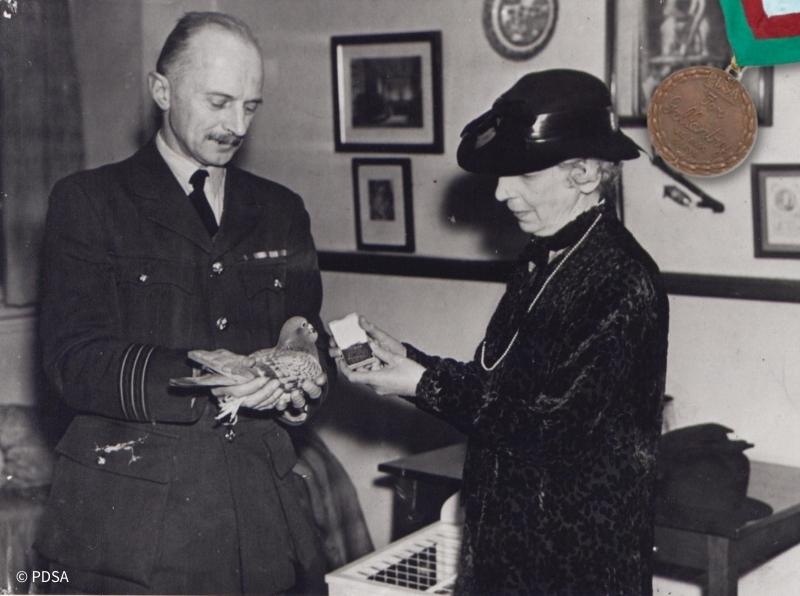Animals have provided a vital service to the armed forces for centuries, from delivering messages to carrying ammunition or offering companionship. 80 years ago, their bravery was recognised for the first time through the Dickin Medal. In our latest blog, we explore the fascinating story behind one of the first recipients of the medal.
What is the Dickin Medal?
On 2 December 1943, Maria Dickin, founder of the animal charity the People’s Dispensary for Sick Animals (PDSA), made huge strides in recognising animal bravery. The Dickin Medal was created to recognise outstanding acts of gallantry and devotion to duty displayed by animals serving with the Armed Forces or Civil Defence units. Regarded as the Victoria Cross for animals, it has, at the time of writing, been awarded 75 times: 38 dogs, 32 pigeons, 4 horses, and 1 cat have received the medal.
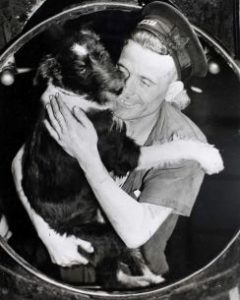
What were animals doing during WWII?
The gallant deeds of our ancestors in the armed forces and on the home front are well documented, but what about the role of animals during WWII? As the British Isles suffered from aerial bombardments during the Blitz, dogs helped to rescue civilians buried in the rubble. They also served with Allied forces overseas, detecting mines, rescuing stranded personnel and even parachuting into enemy territory on D-Day.
Pigeons also played their part, delivering vital messages from operatives working behind enemy lines, bringing news during operations like D-Day or delivering an SOS from downed aircrew. In fact, the first three recipients of the Dickin Medal were pigeons.
Pigeons provide a vital service
The lead-up to WWII witnessed significant advances in communications and mechanised warfare, accelerated by the demands of WWI. It may seem a contradiction of these advances that British forces used pigeons so readily during the war.
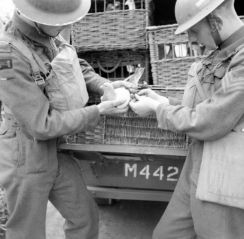
However, they were vital to the military, particularly the Royal Air Force (RAF), especially to downed aircraft or crews forced to land in enemy territory or at sea. When radio equipment was damaged or if radio silence was required to evade enemy transmitters, pigeons could deliver messages safely and, often, silently. As a result, Bomber and Reconnaissance crews carried pigeons in specially designed watertight baskets. While they risked being shot down or falling into enemy hands, they were an important means of communication for the air force.
Pigeons were trained for use by the armed forces by the National Pigeon Service (NPS), established in 1938. During the war, 200,000 pigeons were loaned to the service by pigeon fanciers; these were keepers and breeders of pigeons. One of these pigeons was named Winkie, who carried out a remarkable act of bravery one night in February 1942.
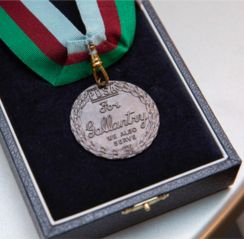
The first recipient of the Dickin Medal
Winkie the pigeon was the first recipient of the Dickin Medal, which she received for her bravery in assisting a downed bomber crew in 1942. Winkie was travelling on board an RAF Bristol Beaufort bomber during a patrol over the Norwegian south coast on 23 February 1942.
Running into difficulty on its return to base at RAF Leuchars in the early evening, the bomber was forced to crash land in the icy sea over 100 miles from home. The crew were able to put out a call sign before crashing, and their base picked up the weak message.
Boarding their inflatable dinghy into the freezing North Sea, the four-man crew escaped the sinking aircraft, carrying their pigeon basket. In an interview after the event, the pilot William Hedley Cliff said:
‘One bird had broken out as the aircraft crashed and she took off before we were able to fix a message to her. That was Winkie – bless her little heart.’
The other pigeon also departed into the night sky, this time carrying a message. Stranded in their dinghy in the cold, choppy conditions, the hopes of the crew lay with two pigeons.
Raising the alarm
Winkie travelled over 100 miles in bad weather back to the loft of her owner, George Ross of Broughty Ferry, Dundee, arriving covered in oil and wet through. Ross, a pigeon fancier, realised that sitting in front of him was the pigeon he had loaned to the RAF. He called the crew’s base at Leuchars, informing them of what he had found.
Based on the oil on her wings, her average flying speed and the time between the plane ditching and Winkie arriving home, the RAF were able to roughly work out the position the plane crashed. The dinghy was spotted in the sea late in the morning of the 24th. All four survived the ordeal thanks to the bravery of Winkie, the pigeon. Nothing, however, was heard of the other pigeon, which set off just after.

A brave little pigeon receives the Dickin Medal
After the rescue, the crew held a dinner in Winkie’s honour, which she was present for. Winkie later received the Dickin Medal from the founder of the PDSA, Maria Dickin, on 2 December 1943, one of three pigeons to receive the medal on the award’s inauguration.
The crew
The crew rescued by Winkie the pigeon were pilot William Hedley Cliff, John Edward McDonald, Ernest Frederick Tessier and John Venn. They were serving with No. 42 (Torpedo Bomber) Squadron, part of RAF Coastal Command. Coastal Command carried out vital work during the war, patrolling the seas from the Arctic Circle in the Atlantic to North Africa, protecting shipping routes and hunting U-boats.
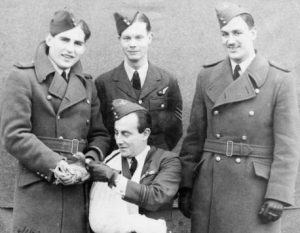
Researching ancestors who served with the RAF during WWII
If your ancestors served with the RAF during WWII, like the crew saved by Winkie, then the following collections could help you learn more about their wartime service:
Service Records
When it comes to researching your ancestor, you’ll want to obtain their service record. Owing to data protection laws, WWII service records are held by the Ministry of Defence (MOD). Your ancestor’s service record will provide key details, like when they enlisted, their ranks, and the squadrons or units they served with. This information could help you research them in other collections, too. You can apply for your ancestor’s WWII RAF service record via the MOD’s website.
Bomber and Fighter Command Losses, 1939-1945
Our Bomber and Fighter Command losses collection concerns incidents relating to British and Allied aircrew during the war. Entries provide an insight into the incident, ranging from those who crash-landed to aircrew who were shot down and killed in action. In addition to the incident details, the collection may record the aircraft they were flying or operating in, its serial number, squadron details, rank, station and where the person was buried or commemorated.
Recipients of the Distinguished Flying Medal, 1939-1945
If you want a collection that offers insight into incidents of bravery and heroics during WWII, then this collection is a must-search. The Distinguished Flying Medal (DFM) was awarded to other ranks of the RAF and Commonwealth air forces for acts of valour, courage or devotion to duty performed while flying in active operations against the enemy. Entries provide a full citation for the award in addition to the recipient’s name, number, rank, squadron and RAF trade.
Royal Air Force Lists, 1919-1945
The air force lists are a must for anyone tracking an officer’s career, particularly when you don’t have their service record. The lists in this collection cover 1919 to 1945 and were produced monthly, bimonthly, and quarterly. Entries often include the person’s name, rank, and date of seniority in that rank.
A positive entry can confirm an ancestor’s association with the RAF and allows you to build up a timeline of their service and promotions.
Cover Image: © PDSA
Sources
PDSA, PDSA Dickin Medal, accessed December 2023.
PDSA, DM 75, accessed December 2023.
PDSA, Winkie, accessed December 2023.
Classic Warbirds, Pigeons at War – The RAF and the National Pigeon Service, accessed December 2023.
Imperial War Museums, How RAF Coastal Command Defended Britain During The Second World War, accessed December 2023.
Newspapers.com, accessed December 2023.
The Royal Pigeon Racing Association, Pigeons in War, accessed December 2023.
Vance Gortman, Uncracked Codes and Ciphers (Lulu.com [online]: 2016).
Vintage Wings of Canada, War Pigeon, accessed December 2023.

